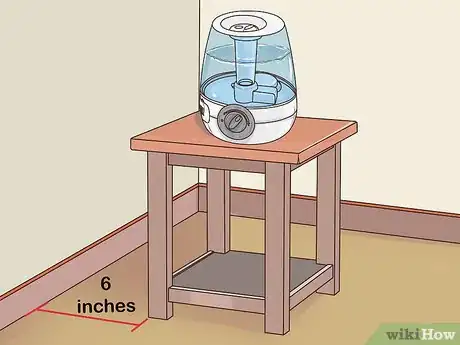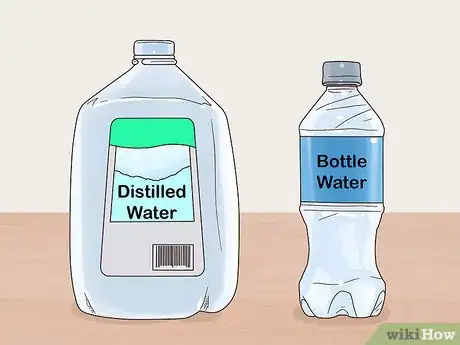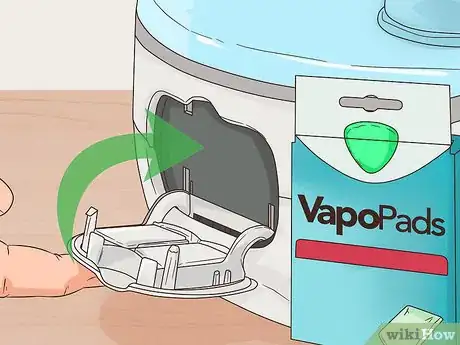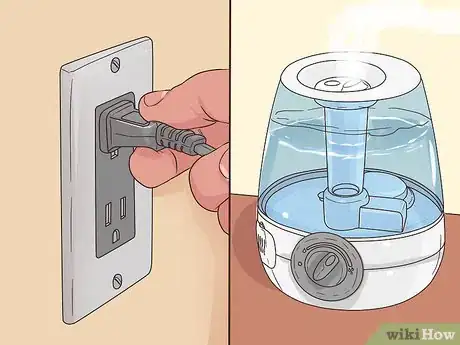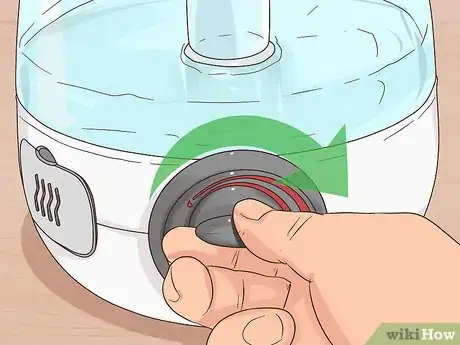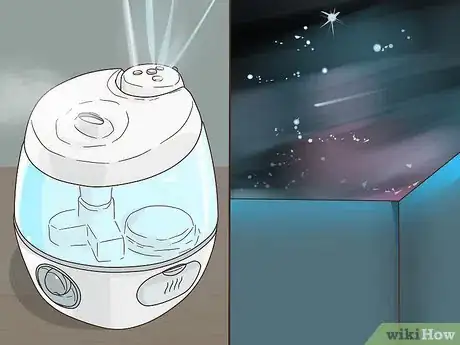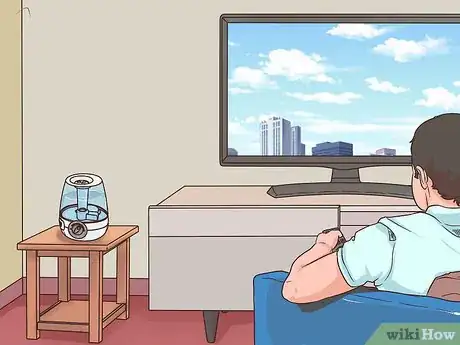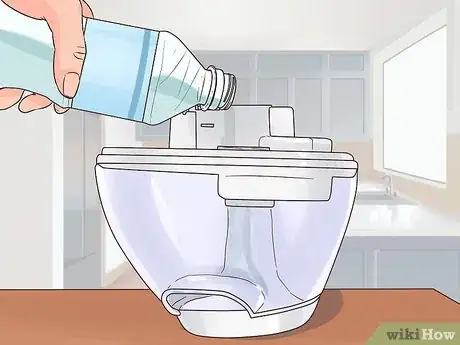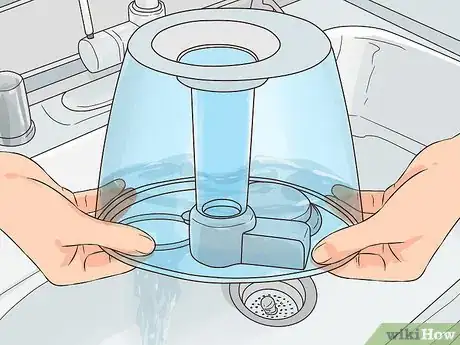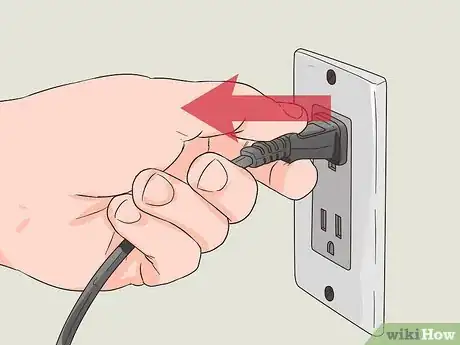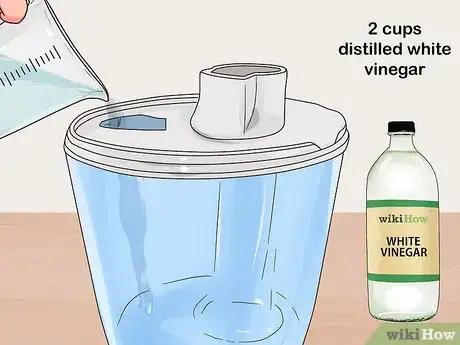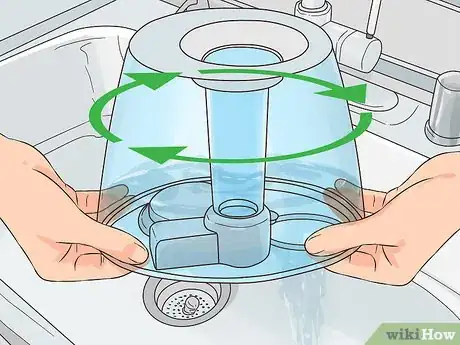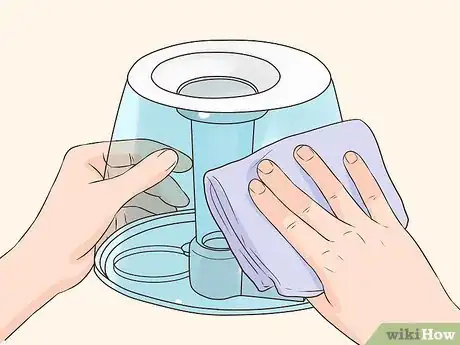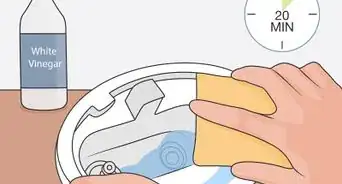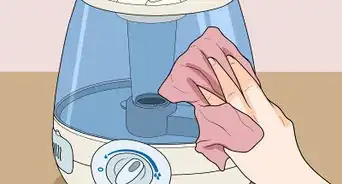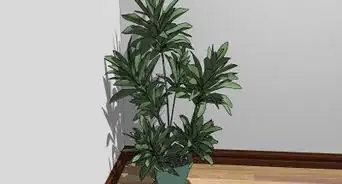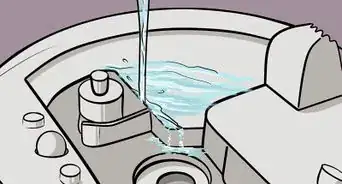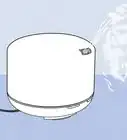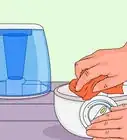This article was co-authored by Victor Belavus. Victor Belavus is an Air Conditioning Specialist and the Owner of 212 HVAC, an air condition repair and installation company based in Brooklyn, New York. In addition to HVAC and air conditioning units, Victor also specializes in furnace repair and air duct cleaning. He has over 10 years of experience working with HVAC systems.
There are 7 references cited in this article, which can be found at the bottom of the page.
This article has been viewed 136,681 times.
Vicks humidifiers are some of the oldest and highest-quality vapor diffusers on the market. If you live in a dry climate or someone in your household struggles with congestion, humidifiers can improve your home's living conditions. Read your humidifier's instructions before you turn it on to make sure you're using it safely. If you use your Vicks humidifier often, clean it at least once weekly to prevent mold or bacterial growth.
Steps
Setting Up the Humidifier
-
1Put the humidifier on a flat, waterproof surface. The surface should be at least 4 feet (1.2 m) away from your bedside and 6 inches (15 cm) away from the wall. If you have any pets or small children, place the humidifier where it will not be disturbed by either.[1]
- Vicks humidifiers should always be carried with both hands to avoid accidentally dropping them.
-
2Purchase bottled or distilled water for your humidifier. Using tap water creates a mineral residue in your humidifier's tank that can promote bacterial growth. Breathing in this bacteria may cause illness, so use bottled, distilled, or purified water every time you use the humidifier.[2]
- If you don't want to use bottled water, you can purify tap water using a filter or water purification tablets.
Advertisement -
3Fill the humidifier tank with cool water. Remove the humidifier tank and turn it upside down to reveal its tank cap. Turn the tank cap in the direction of the open lock symbol (usually counter-clockwise) and fill it with cool water. Screw the cap back in place and place the tank into the humidifier again.[3]
- Never fill the humidifier with warm or hot water.
-
4Insert a VapoPad, if desired. VapoPads allow your humidifier to emit soothing scents, like rosemary, lavender, or menthol, for up to 8 hours at a time. Open the humidifier's scent pad door, then open the scent pad by tearing a notch on the corner of the bag. Insert the VapoPad into the door and close it.
- You can insert up to 2 VapoPads at a time. After 8 hours have passed discard one or both VapoPads.
- Do not touch the inner contents of the VapoPad. If any of the contents get on your hands, was them immediately, as they can cause skin or eye irritation.
-
5Plug your humidifier into the wall. To avoid electrocution, dry your hands off before plugging in your humidifier. When it's plugged in, check your humidifier's positioning again— it should be angled away from walls, furniture, or bedding.[4]
- Make sure no objects are covering the humidifier's steam openings before you plug it in.
Running the Humidifier
-
1Turn the power knob to the desired setting. Twist the knob clockwise to raise the setting and counter-clockwise to lower it. When you have reached a comfortable humidity setting for your needs, leave the humidifier undisturbed until you need to adjust the setting, remove a VapoPad, or refill the machine.
- You might start, for example, by turning it about halfway between low and high and adjusting as needed.
- The lower the setting, the longer your humidifier will run.
-
2Turn on the projector, if applicable. Some Vicks humidifiers come with a projector that plays calming lights and sounds. Slide the projector switch on to use this feature, and turn it off as needed.
- Most projectors can be operated independently of the humidifier if you would prefer to use this feature without the humidity.
-
3Make sure someone is always in the room with the humidifier. Leaving the humidifier alone for too long increases the risk of oversaturated air or other accidents. If you need to leave the room or are going out of the house, remember to switch the humidifier off before you go.[5]
-
4Leave the room door slightly open while using a humidifier. If you leave the door closed, the air could become saturated and leave condensation on the walls, windows, and furniture. Propping the door open will keep the room at a balanced humidity level.
-
5Turn the humidifier down if the room feels moist. If you notice condensation on your walls or windows, the humidity levels are higher than they should be. Unless you are trying to relieve nasal congestion, your air humidity levels should not be high enough that it makes the room moist.[6]
-
6Refill your humidifier when it runs out. You should be able to monitor the water level at any time through its translucent tank. If your humidifier runs out of water and you still want to use it, unplug your humidifier and refill it with water again.
- A water tank should last between 12-18 hours on a medium setting.
-
7Don't let the water sit between uses. Leaving the water in your humidifier for days can cause bacteria to breed in the water. Dump the water out after you are finished using your humidifier, and fill it with fresh water each time you use it.
Cleaning the Humidifier
-
1Clean your humidifier weekly to keep it in good condition. Frequently cleaning your humidifier will prevent bacterial growth. If you use your humidifier often, clean it weekly so it can remain safe to use.[7]
- If you don't use your humidifier more than once per week, clean it after every use.
-
2Unplug your humidifier and remove the tank before you clean it. If you used any VapoPads in your humidifier, take them out of their compartment. Twist the tank cap off and set it aside, then empty any residual water from the tank.
-
3Add 2 cups (470 mL) of undiluted, distilled white vinegar to the tank. Screw the cap back on and swirl the vinegar around the tank, then screw it back into the base. The vinegar solution can then drain into the base and loosen any mineral buildup.[8]
- Never turn on or run the humidifier with the vinegar solution.
-
4Soak the humidifier in vinegar for 4-5 hours. Leaving the vinegar solution in the humidifier for several hours will kill bacteria and loosen any minerals in the tank. If you can see residual minerals in the machine, let the vinegar soak for the full five hours.[9]
-
5Rinse out the tank and base. After soaking the humidifier, unscrew the tank cap and pour the vinegar out in the sink. Turn the base over and pour the vinegar out of there as well. Pour water into the tank and base and swish them out until neither smell like vinegar.[10]
-
6Dry the base and tank out if you're putting the humidifier away for storage. Use a dry cloth to wipe the base and tank dry to prevent mold or bacteria growth. Keep the humidifier in a dry place until you are ready to use it again.
-
7Disinfect the humidifier weekly with bleach. Add 1⁄2 teaspoon (2.5 mL)} of bleach to 1⁄2 gallon (1.9 L) of water and fill the tank with this cleaning solution. Place the tank on the base and let the solution drain into the base. Keep the solution in the humidifier for 15-20 minutes, then empty out both the base and tank in the sink. Pour water into the base and tank and flush the humidifier out until they no longer smell like bleach.
- Never turn on or run the humidifier with the bleach solution.
- Do not use the vinegar and bleach cleaning solutions during the same cleaning session. Mixing these chemicals can cause toxic fumes, so plan a separate day to disinfect your humidifier.[11]
Expert Q&A
Did you know you can get expert answers for this article?
Unlock expert answers by supporting wikiHow
-
QuestionCan you leave a humidifier on all night?
 Victor BelavusVictor Belavus is an Air Conditioning Specialist and the Owner of 212 HVAC, an air condition repair and installation company based in Brooklyn, New York. In addition to HVAC and air conditioning units, Victor also specializes in furnace repair and air duct cleaning. He has over 10 years of experience working with HVAC systems.
Victor BelavusVictor Belavus is an Air Conditioning Specialist and the Owner of 212 HVAC, an air condition repair and installation company based in Brooklyn, New York. In addition to HVAC and air conditioning units, Victor also specializes in furnace repair and air duct cleaning. He has over 10 years of experience working with HVAC systems.
Air Conditioning Specialist
Warnings
- Vicks humidifiers are designed for indoor use only. Do not use your humidifier outdoors, even if you have outside outlets.⧼thumbs_response⧽
- Vicks manufacturers recommend that the humidifier not be used around infants under 10 pounds (4.5 kg) when using a VapoPad.⧼thumbs_response⧽
References
- ↑ Victor Belavus. Air Conditioning Specialist. Expert Interview. 6 May 2020.
- ↑ https://www.mayoclinic.org/diseases-conditions/common-cold/expert-answers/cool-mist-humidifiers/faq-20058199
- ↑ https://homesteady.com/how-8001774-directions-vicks-model-v5100-humidifier.html
- ↑ https://www.vicks.com/es-us/comprar-productos/humidificadores-e-inhaladores-a-vapor/~/media/Vicks/Images/Products/US/Richtext/V425-Vicks-Cool-Mist-Humidifier-Product-Manual.pdf
- ↑ https://www.vicks.com/es-us/comprar-productos/humidificadores-e-inhaladores-a-vapor/~/media/Vicks/Images/Products/US/Richtext/V425-Vicks-Cool-Mist-Humidifier-Product-Manual.pdf
- ↑ https://www.washingtonian.com/2012/01/09/the-right-way-to-use-a-humidifier/
- ↑ https://www.vicks.com/es-us/comprar-productos/humidificadores-e-inhaladores-a-vapor/~/media/Vicks/Images/Products/US/Richtext/V425-Vicks-Cool-Mist-Humidifier-Product-Manual.pdf
- ↑ Victor Belavus. Air Conditioning Specialist. Expert Interview. 6 May 2020.
- ↑ https://www.apartmenttherapy.com/how-to-clean-a-humidifier-apartment-therapy-tutorial-109395
- ↑ Victor Belavus. Air Conditioning Specialist. Expert Interview. 6 May 2020.
- ↑ https://www.doh.wa.gov/YouandYourFamily/HealthyHome/Contaminants/BleachMixingDangers
About This Article
A Vicks humidifier adds moisture to your air and can help clear up congestion, and all you need to do to use one is fill it with water and turn it to the right setting. Start by placing your humidifier on a flat, waterproof surface, like your desk or dresser. Then, fill the humidifier to the fill line with some bottled or distilled water. Try to avoid using tap water since it can cause mineral buildup and bacterial growth. Once you've added the water, just plug your humidifier into a nearby wall outlet and turn the power knob to a comfortable humidity level. Whenever the water runs out, refill the humidifier with more water. To learn how to insert a VapoPad into the humidifier to add a soothing scent, keep reading!
